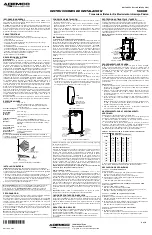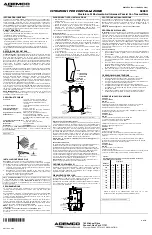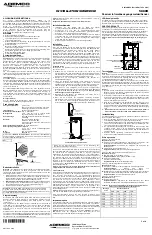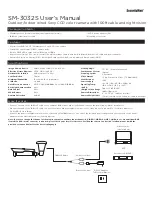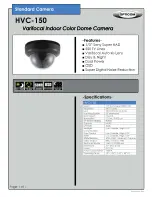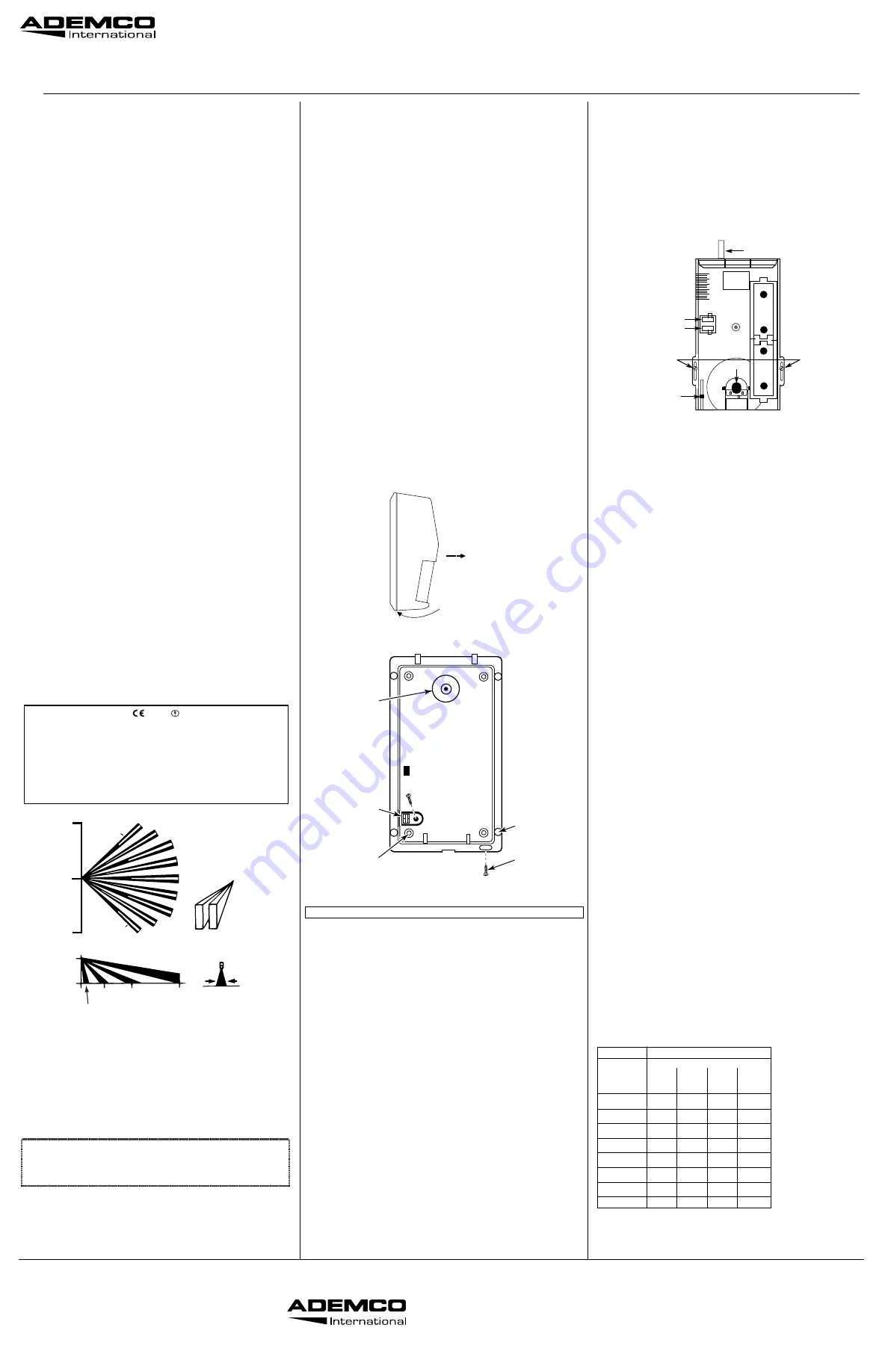
¬.9=l
1
of 8
K0176V2 4/02
180 Michael Drive
Syosset, New York 11791
Copyright © 2002 PITTWAY CORPORATION
K0176ENV2 (Part of K0176V2 4/02)
,167$//$7,21,16758&7,216
+
Passive Infrared Motion Detector/Transmitter
GENERAL INFORMATION
The 5888H Passive Infrared Motion Detector/Transmitter is a battery-operated
wireless device intended for use as part of a 5800H series wireless alarm
system.
Designed for use in commercial and residential installations, the 5888H is a
wall-mounted unit with a standard lens that provides wide-angle protection up
to a range of 12m. For best coverage, mount the detector so that the likely
direction of intruder motion is
across
the pattern.
FEATURES
• Wireless operation for fast installation.
• Dual element pyro-electric sensor provides positive protection while
minimizing false alarms.
• Temperature
compensation.
• Alternate polarity pulse count option offers greater stability in adverse
environments.
• “Look
down”
protection.
• Provision to turn LED on while walk testing (LED is turned off after testing).
• Tamper protection – unit transmits message if cover is removed or if unit is
removed from its mounting surface.
• Wall or corner mounting options.
• Optional swivel mount bracket available (998SB).
SYSTEM DESCRIPTION
Optical System:
Fresnel lens.
Radio Transmitter:
The built-in transmitter can send alarm, tamper, supervisory, and battery
status messages to the system's receiver/control. Each detector has a unique
ID code permanently assigned at the factory that needs to be "enrolled" by the
control during installation. This allows each detector used to be uniquely
identified. “Enroll" the 5888H as an "RF" type unit (i.e., supervised RF).
To conserve battery life during normal operation, no more than one
transmission sequence will occur within a 3-minute period. There is no such
time restriction in "test" mode.
Alternate Polarity Pulse Count:
Two jumper-selectable detection response modes are provided: Instant
response (Pulse Count OFF) and Alternate Polarity Pulse Count (Pulse Count
ON). With Pulse Count OFF, any detected change in infrared energy will
trigger an immediate alarm signal. This mode is recommended when the
detector is used to monitor a narrow hallway where coverage is provided by
only a single zone.
Use the Pulse Count ON mode when the detector is installed in areas where
periodic changes in infrared energy levels are normal (for example, where
forced air heating ducts are present). In this mode, it requires at least two
detected changes in infrared energy within a short period before an alarm will
be triggered.
Important Note:
If the detector is to be used in the Pulse Count mode, be
sure to walk test the unit in this mode.
SPECIFICATIONS
Lens Coverage
: 12 m x 12m.
18 zones (9 long, 5 intermediate, 4 short range) plus 1 look-
down zone directly below the detector.
Pulse Count:
Installer-selectable On/Off link.
Detectable
Walk Rate:
0.15
– 3m/sec.
Mtg. Height:
2.5m, but may be mounted at other heights (see Table 1).
Walk Test
Indicator:
Red LED with ON/OFF (disable) link.
Batteries:
Two
3-volt Lithium batteries. Use only Ademco No. 466,
Duracell DL123A, Panasonic CR123A, Sanyo CR123A,
Varta CR123A.
0perating
Temperature:
–
10°C to +50°C.
Operating
Humidity:
Up to 95% RH (max.), non-condensing.
Dimensions:
74mm x 130mm x 58mm.
Frequency:
868.950MHz
0889
Declaration of Conformity
We, ADEMCO INTERNATIONAL, declare that the 5888H is in conformity with the
R&TTE directive 1999/5/EC and the following technical regulations have been
applied: EN 300 220-1:2000, EN 50130-4:1998, ETS 300 683:1997, EN
60950:2000.
This device is intended for use in the following countries:
Austria Belgium Denmark
Finland
France
Germany
Greece
Iceland Ireland Italy
Luxembourg
Netherlands
Portugal Spain
Sweden Switzerland
United
Kingdom
Note: In Norway, a license is required to operate this device. This has not been
applied for.
TOP VIEW
6m
6m
0
90˚
2.4m
2.4m
6m
12m
DOWNWARD-LOOKING
BEAM 0.3m FROM WALL
1m
DOWNWARD-LOOKING
BEAM
(FRONT VIEW)
ALTERNATE COUNT POLARITY
EACH ZONE CONSIST OF 2 FIELDS
Figure 1.
Protection Pattern, Standard Lens
BATTERY INSTALLATION
WARNING:
There is a danger of explosion if the battery is replaced
incorrectly. Replace battery only with same or equivalent type. Dispose of
used batteries according to the battery manufacturer’s instruction.
1. Remove front cover by inserting and twisting a screwdriver blade (or small
coin) in the groove between cover and base shown in Figure 2.
2. Observing correct polarity, install the two Lithium batteries (supplied
)
into
the battery holders,
as shown in Figure 4, with the [
+
] end of one adjacent
to the [
+
] end of the other.
3. Replace the cover (snap fit).
Programming Note:
I
f the detector’s ID has not been programmed into the system (i.e., for
initial detector installation), refer to the PROGRAMMING section below and
perform the ID “enrolling” procedure before mounting or testing the
detector.
PROGRAMMING
The control must “enroll” the detector’s ID during installation of the system as
an “RF” type unit (i.e., supervised RF).
Refer to the control unit’s Installation
Instructions for a detailed procedure.
To program the detector, place the LED jumper in the ON position (see Fig.
4), the Pulse Count jumper in the OFF position, batteries installed, and cover
on. Temporarily cover the lens (a cloth will do) to prevent any activation by the
detector.
With the control in the programming mode, remove the cover and move your
hand over the lens to activate the detector and cause it to send a FAULT;
then cover the lens again to send a RESTORE.
Note:
Repeat this procedure to verify "enrolling".
Return LED jumper to the OFF position.
INSTALLATION HINTS
•
Do not install where the detector is exposed to direct sunlight or directly
above strong sources of heat.
•
Make sure the detection area does not have obstructions (curtains,
screens, large pieces of furniture, plants, etc.) which may block the pattern
of coverage.
•
Avoid locating a unit in areas which contain objects likely to produce a
rapid change in temperature, such as central heating, radiators or ducts (or
heaters of any kind), air conditioners, open flame, etc.
•
Do not mount on an unstable surface.
INSTALLATION
Radio Transmission Path Check
Verify that a strong transmission path between the 5888H and the system's
Receiver/Control exists
before permanently mounting the detector.
Do this
by performing the Walk Test (described later) with the detector temporarily
mounted in its proposed location.
The 5888H will transmit when sensing motion (waving arm or walking into
area). Sometimes, moving the detector only a few centimeters means the
difference between a strong and weak transmission path. Experiment until
you are satisfied that the location provides the strongest transmission path,
while still being practical for the protection pattern desired. This test also
verifies that the detector has been correctly programmed into the system.
Normal Mounting
Mount the unit to a firm vertical surface (flat on wall or in corner).
1. Remove front cover.
2. Break off plastic tab protruding up from the top of the PCB plastic cover.
3. Temporarily loosen (do not remove) the screw holding the PC board in
the detector base (see Fig. 4 for location of this screw). The board can
then be moved up or down for access to the knockout mounting holes in
the base.
4. See Figure 3 for location of these knockout holes. Break out only those
holes required.
5. Mount the detector with screws, using the selected mounting holes.
6. Before fully tightening the PC board holding screw, make sure the board
is positioned so that the arrow is in line with the appropriate setting on the
graduated scale on the right-hand side of the PC board (see Table 1, and
Fig. 4).
1) INSERT
SCREWDRIVER
HERE AND TWIST
2) LIFT COVER
Figure 2. Cover Removal
KNOCKOUT
FOR SWIVEL
MOUNT
BRACKET
B
A
A
A
A
B
B
B
KNOCKOUT
"A" (4) FOR
SURFACE
MOUNTING
COVER
LOCKING
SCREW
KNOCKOUT
"B" (4) FOR
CORNER
MOUNTING
WALL
REMOVAL
TAMPER
TAB
5888eu_us-001-V0
Figure 3. Mounting Holes in Base
Use cover locking screw when required for regulatory agency approval.
Vertical Pattern Adjustment
The protection pattern can be raised or lowered by re-positioning the PC
board in the detector. A graduated scale on the left of the PCB cover (see Fig.
4) indicates the approximate number of degrees by which the pattern can be
raised (max. +5°) or lowered (max. -20°). To make this adjustment, loosen the
screw holding the PC board (the screw is located on the left side of the board
cover). Slide the board upward or downward by the number of degrees
required, then tighten the screw. After any adjustment, conduct a walk test to
ensure proper coverage of the area to be protected, as indicated in "
Test
Procedures."
NOTE: Be sure to fully tighten the PCB locking screw after adjustment.
Lens Masking
The masking strips that have been supplied are designed for application to
one or more lens segments to produce a protection pattern that suits the
particular requirements of the protected area. Simply peel off the appropriate
pressure-sensitive adhesive strip(s) and apply over the desired lens
segment(s). Be sure to affix the masking strips to the inside of the lens (not
the outer, smooth side). Each lens segment that is masked results in the
elimination of one zone of protection from the coverage pattern. By masking
segments of the lens, you can adjust the coverage to suit the area to be
protected or eliminate coverage from areas where you anticipate
environmental disturbances that might reduce the PIR's stability (a heater or
other heat-producing object for example).
Important:
When hallway pattern masking is used, be sure the PIR is set for
instant response.
PULSE COUNT OPTION
Each detector includes Pulse Count circuitry that is designed to provide
stability in adverse environments to minimize false alarms. Pulse count is
selected by positioning a jumper across the ON pulse count terminals (shown
in Figure 4). When set for pulse count, the detector will signal an alarm within
2 or 3 steps of an intruder.
LED DISABLE
The detector is shipped with the LED disabled (LED jumper in the "OFF"
position). The LED may be enabled (for the "Walk-Test") by positioning the
LED jumper in the "ON" position (see Fig. 4).
Note:
When the jumper is in the "OFF" position, the LED will not light, but the
built-in transmitter will transmit alarms when the PIR senses motion.
TAMPER PROTECTION
For protection against wall removal of the detector when the detector is flat
wall mounted, screw the wall removal tamper tab to the wall when mounting
the detector (wall removal tamper protection is not provided when the detector
is corner mounted). When the detector is pried from the wall, the tamper tab
will break off and remain on the wall. This will activate a tamper switch in the
detector and cause transmission of a tamper signal. This signal will also be
transmitted when the detector’s front cover is removed.
NOTE: PCB locking screw must be fully tightened.
+5
0
-5
-10
-15
-20
• • •
• • •
REAK OFF
+
–
+
–
BREAK OFF TAB
PCB
LOCKING
SCREW (2)
TAMPER
SWITCH
3
VOLT
BATTERY
3
VOLT
BATTERY
LED
DET
ON
ON
LED
PULSE
COUNT
Figure 4. PC Board and Cover
TEST PROCEDURES
Important:
Testing should be conducted with the protected area cleared of all
people. Place the system control in the Test mode for the walk test procedure
– when the PIR senses movement, a "beep" will be heard from the control or
keypad, and verify that the PIR's transmitter signal has reached the control's
wireless receiver.
The absolute range of all PIR units is subject to variation because of different
types of clothing, backgrounds and ambient temperature. For this reason,
ensure that the most likely intruder routes are well within the PIR's protective
zones and that walk-testing is carried out along these routes.
Walk-Test
1. Remove front cover and set the Pulse Count jumper in the detector in the
OFF position initially. The LED must be enabled at this time (jumper in
the ON position).
2. Replace front cover and walk through protective zones, observing that the
detector's LED lights whenever motion is detected (the LED serves as a
Walk-Test indicator during this procedure).
3. If pulse count is going to be used in this installation, set the pulse count
jumper to the ON setting and repeat the walk test procedure.
Note:
If pulse count mode is used during the walk test, the LED will stay
lit for approximately 1 to 3 seconds after detecting motion.
4.
After the "Walk-Test" is completed, the LED jumper should be
placed in the OFF position (LED disabled).
MAINTAINING PROPER OPERATION
In order to maintain the detector in proper working condition:
1. Replace
both
batteries within 7 days after a "low battery" message has
appeared in the system's display.
2. Detectors should never be re-aimed or relocated without the advice or
assistance of the alarm service company.
3. The physical surroundings of the protected area should not be changed. If
furniture or stock is moved, or air-conditioning or additional heating is
installed, the PIR may have to be readjusted.
4. Walk-tests should be conducted frequently (at least weekly) to confirm
continued proper coverage.
TROUBLESHOOTING
Trouble 1:
INTERMITTENT ALARM
Probable Causes:
A. Rapid temperature change. Check for electric or gas heaters, open
flames, electric arcs, etc.
Remedy:
Locate source and reposition detector.
B. Drafts causing drapes, light fixtures, display material to move.
Remedy:
Eliminate source of motion.
Trouble 2:
LED INOPERATIVE DURING WALK TEST
Probable Causes:
A. LED control jumper set to OFF.
Remedy:
Reposition jumper to ON position.
B. LED malfunction. Check for broken/shorted leads.
Remedy:
Return unit for service.
Trouble 3:
DETECTION AREA CHANGES
Probable Causes:
A. Repositioned furniture or equipment in the protected area.
Remedy:
Caution customer about layout changes. Reposition detector.
B. Mounting surface is unstable. A few degrees of vertical shift can change
range substantially.
Remedy:
Mount on secure surface.
Trouble 4:
UNIT DOES NOT APPEAR TO BE OPERATING
Probable Cause:
A. Unit is not receiving power.
Remedy:
Check for appropriate battery voltage. Install new batteries if
necessary. Be sure to change both batteries.
TABLE 1.
Detector Board Vertical Settings
For Various Mounting Heights And Ranges
Detection Range
Nominal _____________________________
Height
4.6m
6m 9m 12m
2.6m
–20°
–17°
–11°
–9°
2.5m
–20°
–16°
–11°
–8°
2.4m
–20°
–15°
–10°
–8°
2.3m
–19°
–14°
–10°
–7°
2.2m
–17°
–13°
–9°
–7°
2.1m
–16°
–12°
–8°
–6°
2.0m
–15°
–11°
–8°
–6°
1.9m
–14°
–11°
–7°
–5°
1.8m
–13°
–10°
–6°
–5°
See Fig. 4 for location of adjustment scale on PC board (refer also to
"Vertical Pattern Adjustment")


